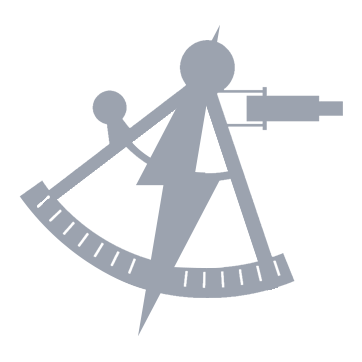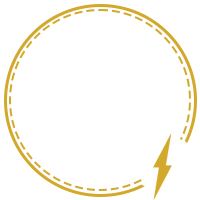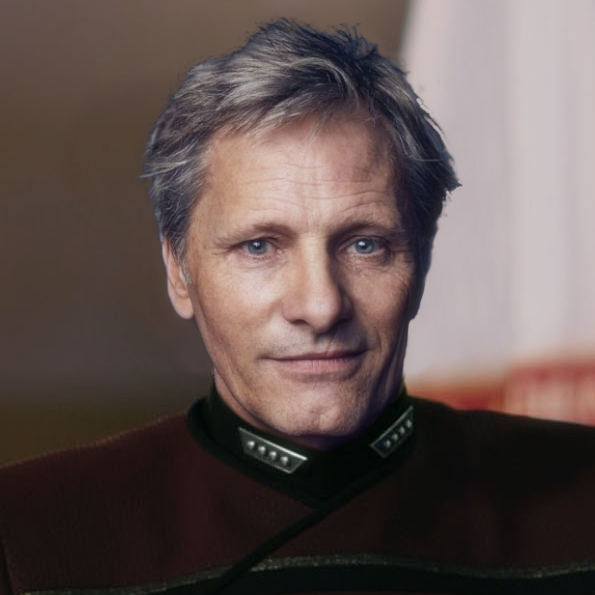In ripples and blurs, darkened rock and frozen dust stirred, not in a wind-blown pattern, but as if each grain had a mind of its own. Every contour seemed uncertain, each luminous flicker not a reflection but a contradiction, almost as if Chorad IXa couldn’t agree on its own truth.
Fleet Admiral Allison Reyes stared at the main viewer, trying to process what she was seeing, but coming up short. Even with the luxury of telemetry scrolling across a half dozen screens before her, Commodore Olivia Larsen was doing no better. Belowdeck, Dr. Tom Brooks was studying the same feed with delight, not because he understood it, but because he didn’t.
“I think we’re close enough,” Fleet Captain Gérard Devreux offered, less concerned with the mystery than the safety of ship and crew. “Conn, engage reverse thrusters. Full stop.” Any closer and the outermost chronometric field lines might start licking at their hull.
“Full stop, aye,” Commander Reza confirmed, not needing to be told twice. His readings of the space ahead showed turbulence, not of solar winds or ionized clouds, but of something less coherent, jagged pockets and fractured seams in the curvature of spacetime itself. It was best not to fly headlong into that.
“What of our babysitters?” Fleet Captain Devreux asked. “What are the Choradian ships doing?” Begrudgingly, Overwarden Var had relented and permitted them to visit their haunted moon, but only under his watchful eye.
“Oh, they pulled off about fifty AU back,” Captain Titus Bishop reported. “Just sitting there on the periphery, menacing at us as best they can.”
For Fleet Admiral Reyes and Commodore Larsen, however, the operational chatter barely registered. Maneuvering commands and the Choradian cutters behind them felt insignificant compared to the impossible unfolding before them.
“Anyone want to offer a guess?” Fleet Admiral Reyes finally asked.
“To hazard a hypothesis would require some semblance of comprehension,” Commodore Larsen replied. “And right now, I don’t have any of that.” She looked over at the operations station. “Elena, anything you can do to true up our scanners? I’d like to at least know what I’m looking at.” The readings were all jumbled and confused, and at present, she was getting more from straight visuals than from anything their sophisticated arrays were streaming back.
“I’m trying,” Lieutenant Commander Elena Mattson replied, her fingers dancing across the keys as she continued correcting offsets and modulating harmonics. “The moon’s chronometric field, it’s scattering every sensor band, EM, gravimetric, subspace, you name it…”
“Almost right, but not quite,” came a voice as the turbolift opened and an old man with messy hair and a wrinkled teal uniform emerged, a grin present beneath his disheveled beard. “It’s not that it’s scattering it, but rather that it’s decohering it.”
Fleet Admiral Reyes turned and smiled. “I was wondering when you might be joining us up here, Tom.” The weird and the wacky were Dr. Brooks’ domain, and she’d never known him to miss out on a spectacle as weird and as wacky as this.
Commodore Larsen just wanted some answers. “Go on, Dr. Brooks.”
“Sensors of all types rely on a basic assumption that events follow in sequence: emission, propagation, reflection, and receipt,” Dr. Brooks explained. “But here, those carrier waves are hopping through pockets of spacetime out of temporal phase with each other, bosons reaching their destination before they’ve crossed the distance, and the bounceback happening before the signal is even sent.”
“Not sure how to keep up with that,” Lieutenant Commander Mattson admitted.
“You can’t,” Dr. Brooks chuckled, enjoying this all a bit more than she was. “The notion of keeping up implies a belief in the directional progression of time, and that, my dear, is what is flawed in your approach.” He strode towards the front of the bridge, pointing at a jagged set of structures on the lunar surface. “Full magnification, here.”
Lieutenant Commander Mattson looked to the command staff for clarification.
“This is Tom’s show for now,” Fleet Admiral Reyes shrugged. “Do it.” She knew better than to question Tom’s intuitions when physics was having an identity crisis.
As the image zoomed in, they could make out splotches of a vast facility stretching across the lunar surface. Parts shimmered under the light of the distant K0V main sequence star, while others lay cloaked in darkness, sharp lines of day and night cutting through what should have been a single structure. Then there were the absences too, entire portions of habitation modules completely missing. Not destroyed, for there was no rubble, but rather simply not present, only barren rock where they should have been.
Fleet Captain Devreux gasped. “What are we looking at?”
“The better question is when are we looking at,” Dr. Brooks replied giddily. “And the answer to that is many different moments… moments when it is day, and moments when it is night… moments when the base is there, and moments when it’s somewhere else, the moon having rotated it out of frame.”
“That’s… disorienting,” Fleet Captain Devreux replied uncomfortably as he stared at the astrophysicist. “You seem to be enjoying yourself a bit too much, Tom.”
“It’s not often you get to see spacetime sliced like prosciutto,” Dr. Brooks grinned.
“Yes, well, that prosciutto used to be home to real people,” Fleet Captain Devreux admonished.
“And they may still be,” Dr. Brooks reminded them, thinking back to what Overwarden Var had shared. “But thanks to Starfleet gifting us primitive systems that falsely assume temporal linearity, no way we’re going to find out from up here.”
“What’re you proposing, Tom?” Fleet Admiral Reyes asked warily, a sense for where he was going.
“A field trip,” Dr. Brooks replied with almost childlike confidence.
Fleet Admiral Reyes’ expression hardened, and Fleet Captain Devreux visibly paled at the thought, but it was Commodore Larsen who beat them both to the punch. “Absolutely not! We know far too little about the dynamics in play, and all we actually know for certain is that the prior attempt by the Choradians met with disaster.”
Dr. Brooks smirked, “A measly attempt by primitive primates.”
“Tom, be real,” Fleet Admiral Reyes shot back. “Are we really all that much less primitive in the grand scheme of things?”
“Speak for yourselves,” Dr. Brooks shrugged. He had ideas, ways that they could pass through those fractures without becoming completely unstuck in time, and he quite fancied the prospect of stepping through moments.
“Let’s start with a probe,” Fleet Admiral Reyes replied pragmatically.
“That seems a sensible next step,” Commodore Larsen agreed before Dr. Brooks could protest. “Operations, ready a Type XIV multi-spectrum reconnaissance probe. Set for a high elevation overflight of the anthropogenic facility at one-four-four by two-three-one.”
“Probe ready,” Lieutenant Commander Mattson confirmed.
“Launch,” Fleet Admiral Reyes ordered.
With a flash of blue from its thrusters, the probe streaked away, and in tandem, Dr. Brooks stepped to the side, leaning up against a support pylon and tapping his foot against the deck, just waiting for what would inevitably follow.
As the probe arced away from the Polaris, Lieutenant Commander Mattson projected the visual feed from the probe up onto the main viewer. At first, it appeared as one would expect, the moon growing larger and larger within the frame, but then the stream began to stutter, frames overlapping, flickering through impossible instants until it was nothing but a blur.
“Stand by,” Lieutenant Commander Mattson offered. “Let me try to clear it up.”
At first, nothing she did was working.
“Try demuxing via non-sequential timestamps,” Dr. Brooks offered amusedly, already fairly certain what was happening.
Much to Lieutenant Commander Mattson’s surprise, Dr. Brook’s suggestion worked, and for the benefit of the onlookers on the bridge, she split the viewer into a six-way multicast.
One feed showed the probe’s approach as it should have been as it made its way away from the ship, but four others showed impossible moments, different points of its overflight that it couldn’t have already reached. The last, though, was most disorienting, the probe falling towards the surface, the landscape stretching until it was impossibly close. And then it cut out.
“Guess we know the probe’s fate,” Dr. Brooks smiled, nodding at the sixth feed.
“But we just launched it,” Fleet Captain Devreux protested. “It’s just beginning its descent.”
“In one frame of reference, sure,” Dr. Brooks observed. “But Elena, if you’d be a dear, could you triangulate the transmission of those last packets right before we lost the sixth feed?”
“Ummm… yeah, stand by,” Lieutenant Commander Mattson replied as she pulled up the last few seconds of the sixth feed and correlated the point of origin. “Alright, I’ve got it.”
“Let’s see what it looks like from up here,” Dr. Brooks requested. “On screen.”
Lieutenant Commander Mattson cast the visual feed from the ship onto one side of the monitor, while leaving it split-screened against the true feed of the probe they had just launched.
At first, from their orbital viewpoint, they saw nothing but a barren patch of the lunar landscape on the new display. But then there was a flash of light, a stellar object falling impossibly fast, and then a puff of dust. As it cleared, they saw a crater, the crater of their probe hitting the surface of the moon, all while the probe was still just beginning its descent away from the ship.
Dr. Brooks smiled. “It’s not often you get to see the beginning and the end all at once.”

 Bravo Fleet
Bravo Fleet








